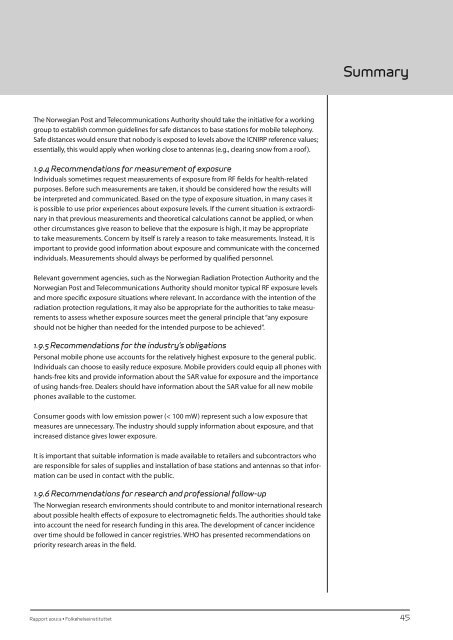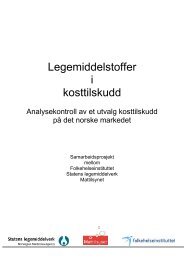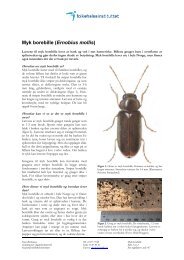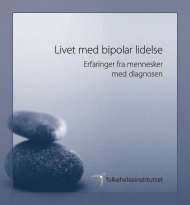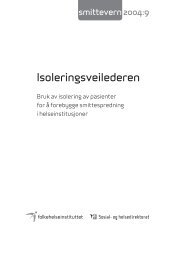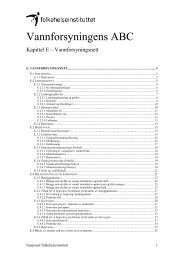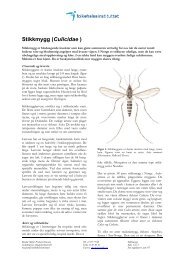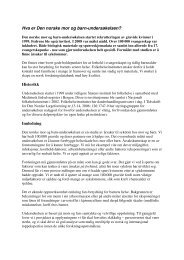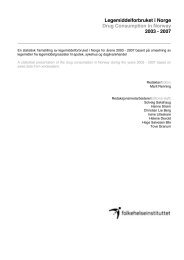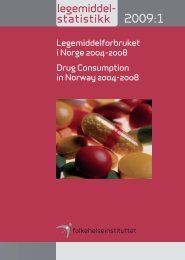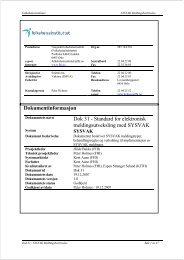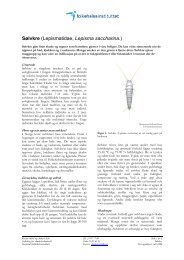rapport 2012:3 - Nasjonalt folkehelseinstitutt
rapport 2012:3 - Nasjonalt folkehelseinstitutt
rapport 2012:3 - Nasjonalt folkehelseinstitutt
Create successful ePaper yourself
Turn your PDF publications into a flip-book with our unique Google optimized e-Paper software.
The Norwegian Post and Telecommunications Authority should take the initiative for a working<br />
group to establish common guidelines for safe distances to base stations for mobile telephony.<br />
Safe distances would ensure that nobody is exposed to levels above the ICNIRP reference values;<br />
essentially, this would apply when working close to antennas (e.g., clearing snow from a roof).<br />
1.9.4 Recommendations for measurement of exposure<br />
Individuals sometimes request measurements of exposure from RF fields for health-related<br />
purposes. Before such measurements are taken, it should be considered how the results will<br />
be interpreted and communicated. Based on the type of exposure situation, in many cases it<br />
is possible to use prior experiences about exposure levels. If the current situation is extraordinary<br />
in that previous measurements and theoretical calculations cannot be applied, or when<br />
other circumstances give reason to believe that the exposure is high, it may be appropriate<br />
to take measurements. Concern by itself is rarely a reason to take measurements. Instead, it is<br />
important to provide good information about exposure and communicate with the concerned<br />
individuals. Measurements should always be performed by qualified personnel.<br />
Relevant government agencies, such as the Norwegian Radiation Protection Authority and the<br />
Norwegian Post and Telecommunications Authority should monitor typical RF exposure levels<br />
and more specific exposure situations where relevant. In accordance with the intention of the<br />
radiation protection regulations, it may also be appropriate for the authorities to take measurements<br />
to assess whether exposure sources meet the general principle that “any exposure<br />
should not be higher than needed for the intended purpose to be achieved”.<br />
1.9.5 Recommendations for the industry’s obligations<br />
Personal mobile phone use accounts for the relatively highest exposure to the general public.<br />
Individuals can choose to easily reduce exposure. Mobile providers could equip all phones with<br />
hands-free kits and provide information about the SAR value for exposure and the importance<br />
of using hands-free. Dealers should have information about the SAR value for all new mobile<br />
phones available to the customer.<br />
Consumer goods with low emission power (< 100 mW) represent such a low exposure that<br />
measures are unnecessary. The industry should supply information about exposure, and that<br />
increased distance gives lower exposure.<br />
It is important that suitable information is made available to retailers and subcontractors who<br />
are responsible for sales of supplies and installation of base stations and antennas so that information<br />
can be used in contact with the public.<br />
1.9.6 Recommendations for research and professional follow-up<br />
The Norwegian research environments should contribute to and monitor international research<br />
about possible health effects of exposure to electromagnetic fields. The authorities should take<br />
into account the need for research funding in this area. The development of cancer incidence<br />
over time should be followed in cancer registries. WHO has presented recommendations on<br />
priority research areas in the field.<br />
Summary<br />
Rapport <strong>2012</strong>:3 • Folkehelseinstituttet 45


